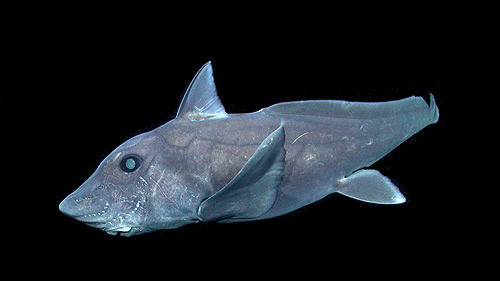Inside of ancient shark skull reveals evolutionary origins of eerie ghost sharks
Mysterious ghost sharks share features with prehistoric symmoriiform sharks
Ghost sharks have been incredibly difficult to fit into the evolutionary tree of life because of their strange appearance – they just don't look much like anything else alive. But scientists have now found out where they fit in by finding fossilised shark skulls that have chimera-like traits.
These peculiar fish are also known as chimeras because of their strange features, such as enormous eyes. These eyes were the clue to where it fits in the evolutionary tree of life. Chimeras' eyes are so big that the cavities that hold them distort the shape of the animal's brain.
There are only 47 species of chimera described so far, and finding out whether any of their stranger features are shared by either modern or prehistoric animals can help put them in evolutionary perspective.
A group of scientists investigated whether any of these features were hidden out of sight in prehistoric sharks, publishing their results in a paper in the journal Nature.

The scientists looked at the inside of a fossil of the skull of an extinct shark to see whether it had any resemblance to chimera skulls. The shark skull was from a Dwykaselachus, found in 280-million-year-old sediments in South Africa.
The outer braincase of the shark was ostensibly as would be expected for the prehistoric group of symmoriiform sharks to which it belongs. It was less easy to examine the interior of the delicate skull. It's made of just a thin layer of fossilised cartilage and is a very rare specimen, as most – even if they are fossilised – get crushed.
The researchers used CT scans to examine the inside of the skull without damaging it. They revealed that on the inside of the skull there were exceptionally large cavities for the eyes – which could be a tell-tale evolutionary left over from a common ancestor with ghost sharks.

The large eyes are thought to be an adaptation to finding food in very low light levels. Modern ghost sharks live at depths of up to 2,500 metres.
"As highly visual foragers, large eye diameter in fishes is a signal of dim-light vision, and the prominent orbits of early and recent chimaeroids suggest a corresponding functional adaptation," the authors write in the paper.
The large eye sockets of the symmoriiform sharks suggest that adaptation to the dark made it predisposed to adapt to life in the deep sea, they write.
Recently a pointy-nosed blue chimera was spotted in the Northern Hemisphere for the first time.
© Copyright IBTimes 2025. All rights reserved.






















